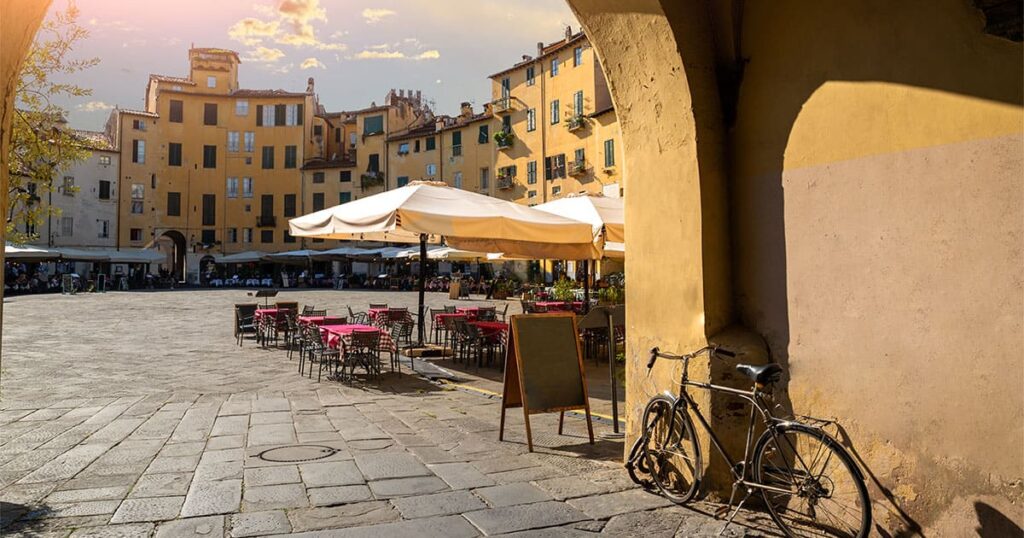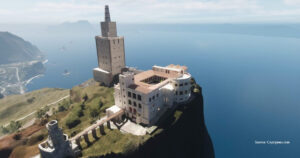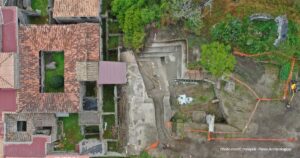Begin your journey in Lucca by embracing the skies. Scale the formidable walls, ascend the historic Guinigi Tower, or brave the 207 steps of the towering Torre delle Ore for a breathtaking view.
From these heights, feast your eyes on a mesmerizing tapestry of rooftops, a mosaic that weaves together Lucca’s Roman roots and current splendor.
Discover Lucca with expert guides
For those eager to dive deeper into Lucca’s enchanting landscape and rich history, consider enhancing your experience with a guided tour. To explore what Lucca offers, check out the best tours in Lucca offered by See Amalfi Coast Private Tours by Vito. These carefully curated tours bring you closer to the heart of this Tuscan treasure, ensuring a memorable journey through its charming streets, historical sites, and breathtaking natural scenery.
The storybook squares of Lucca
Piazza dell’Anfiteatro, a name echoing its glorious past, sits on the grounds of an ancient Roman amphitheater. Nearby, the Church of San Michele, once the bustling Roman Forum, anchors the city. Wander along the vibrant Via Fillungo and San Paolino, modern-day veins of Lucca’s social and shopping life, tracing the ancient Roman decumans.
Lucca, a welcoming haven, boasts orderly streets, a delightful culinary scene, and untouched nature. While known among the youth for the Lucca Comics & Games festival, it is often a fleeting stop before Pisa, yet Lucca demands more than a hurried visit. Spend at least three days to truly immerse in its evening allure and explore quaint neighboring villages.
Piazza dell’Anfiteatro: a Renaissance canvas
Piazza dell’Anfiteatro, a jewel in Lucca’s crown, was reborn in 1830 under Architect Nottolini’s vision, honoring its Roman amphitheater heritage. Despite sacrificing much of the Roman relics, glimpses into the past peek through the shops encircling the square. Its harmonious embrace, accessible from grand entrances, is accessed through quaint arched doorways, creating a secluded haven. This bustling square, with its cafés and markets, is the pulsating heart of Lucca, cherished by locals and travelers alike.
The Cathedral of Lucca: a mosaic of history and art
The Cathedral of Saint Martin, a masterpiece of asymmetry, blends seamlessly with its ancient bell tower. Admire the polychrome façade reminiscent of Pisa’s Cathedral and discover the labyrinth symbolizing life’s journey. Inside, the Funeral Monument of Ilaria del Carretto and revered artworks like the Volto Santo and masterpieces by Ghirlandaio and Tintoretto await. Ascend the bell tower for a panoramic embrace of Lucca.
The Cathedral Museum: a treasure trove of art and history
Steps away, the Cathedral Museum unfolds in eight rooms, showcasing the choir, illuminated manuscripts, and the Jewels of the Holy Face. Nearby, the Monumental and Archaeological Complex of San Giovanni and Santa Reparata reveals layers of Lucca’s history.
San Michele and San Frediano: spiritual beacons of Lucca
Lucca, the ‘city of 100 churches,’ is home to the splendid San Michele and San Frediano. Rising from the ancient Roman Forum, San Michele boasts a striking façade topped with Saint Michael the Archangel. San Frediano captivates with its unique facade mosaic and exquisite baptismal font.
The Majestic walls of Lucca: a living legacy
Lucca’s Walls, an architectural marvel, stretch over 4 kilometers. More than just fortifications, these walls are a vibrant space for leisure, sports, and enjoying stunning city views. A testament to their design, they have stood the test of time, protecting Lucca from historical floods and wars.
Exploring Lucca: practical information
The Cathedral, Bell Tower, Museum, Baptistery, and Church of Saints Giovanni and Reparata beckon with their history and art. Visit their official website for detailed visiting hours and ticket prices.
Medieval Marvels: Guinigi tower and Torre delle Ore
In an era where Lucca boasted 250 towers, only two stand today – the Guinigi Tower and the Torre delle Ore. The Guinigi Tower, a 15th-century marvel erected by the affluent Guinigi family, rises 45 meters high. Its crowning glory is a rooftop garden, where holm oaks have thrived for centuries, offering a serene respite from the 230-step ascent.
The Torre delle Ore, a magnet for timekeeping aficionados, houses a 1754 clock mechanism still ticking away. Climbing its 207 steps rewards you with a view even more stunning than its counterpart.
Exploring Lucca’s towers: a practical guide
- Guinigi Tower: Open from 9:30, with varying closing times throughout the year. Admission: €5.
- Torre delle Ore: Seasonal opening times, closed in winter. Admission: €5.
- Location: Via S. Andrea, in the historic center.
Artistic Splendor at Palazzo Mansi
The 17th-century Palazzo Mansi, once the domicile of the affluent Mansi family, now houses Lucca’s premier art collection. The journey begins with opulent family apartments, leading to an art gallery boasting masterpieces like “The Triumph of Galatea” by Pietro Testa and “Saint Sebastian” by Luca Giordano.
Visiting Palazzo Mansi
- Open: Tuesday to Saturday, with guided tours only.
- Admission: €4 (full), €2 (reduced).
- Location: Via Galli Tassi 43, near the Church of San Michele.
Piazza Napoleone: Lucca’s Grand Square
Piazza Napoleone, named after Elisa Bonaparte, doesn’t quite match Piazza dell’Anfiteatro’s charm but holds its significance. This square, once a fortress, now houses the Ducal Palace and is a lively hub filled with shops, bars, and restaurants.
Giacomo Puccini’s Legacy at Casa Museo Puccini
The birthplace of Giacomo Puccini in Corte San Lorenzo is a pilgrimage site for music lovers. This house museum, adorned with scores, photos, and artifacts, tells the tale of the composer behind operatic masterpieces like Tosca and Madama Butterfly.
Exploring Puccini’s roots
- Open: Varies seasonally, closed on Tuesdays.
- Admission: €9.
- Location: Corte San Lorenzo, in the heart of Lucca.
Palazzo Pfanner: a cinematic journey
Palazzo Pfanner, a 17th-century palace with a stunning Baroque garden, has graced several film sets. The Prince Federico suite offers an immersive experience with its frescoes and panoramic views.
Visiting Palazzo Pfanner
- Open: April to November, 10:00 – 18:00.
- Admission: €6.5 for both garden and palace.
- Location: Via degli Asili, 33, near the Walls of Lucca.
Devil’s Bridge and Beyond: Lucca’s Natural Wonders
The Serchio River Park and neighboring villages like Montecarlo and Capannori are just minutes from Lucca’s center. The Devil’s Bridge’s medieval “donkey-back” design is a testament to architectural ingenuity.
Lake Vagli: a submerged mystery
An hour’s drive from Lucca, Lake Vagli offers a serene environment and a fascinating history with the submerged village of Fabbriche di Careggine, occasionally visible during lake drainages.
Torre del Lago – Puccini’s retreat
This area, a 30-minute drive from Lucca, is where the renowned composer Giacomo Puccini called home. His villa, now a museum, and the picturesque Lake Massaciuccoli and the Puccini Festival make it a cultural and natural haven.




